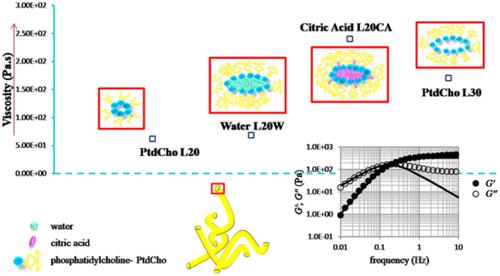当前位置:
X-MOL 学术
›
J. Surfactants Deterg.
›
论文详情
Our official English website, www.x-mol.net, welcomes your feedback! (Note: you will need to create a separate account there.)
Self‐Organizing Structures of Phosphatidylcholine in Nonaqueous Solvents: Tailoring Gel‐like Systems
Journal of Surfactants and Detergents ( IF 1.6 ) Pub Date : 2020-05-22 , DOI: 10.1002/jsde.12422 Paula K. Okuro 1 , Antonio A. Malfatti‐Gasperini 2 , Luiz H. Fasolin 1 , António A. Vicente 3 , Rosiane L. Cunha 1
Journal of Surfactants and Detergents ( IF 1.6 ) Pub Date : 2020-05-22 , DOI: 10.1002/jsde.12422 Paula K. Okuro 1 , Antonio A. Malfatti‐Gasperini 2 , Luiz H. Fasolin 1 , António A. Vicente 3 , Rosiane L. Cunha 1
Affiliation

|
In this paper, we investigated the role played by solvent type and additives (water [W] and citric acid [CA]) on the self‐assembly of phosphatidylcholine (PtdCho) into gels. Soybean lecithin (L) served as the PtdCho source used in this study. Lecithin was combined with different oils: hexadecane (HEX), sunflower oil, and medium‐chain triacylglycerol to explore its ability to form organogels. Among the solvents, only HEX was able to form a translucent self‐sustainable gel with lecithin. It was found that the lower water solubility and viscosity of HEX favored gel formation. Small‐angle X‐ray scattering revealed different structures arisen from lecithin organization depending on the organic medium type. In addition, the gel properties of the L‐HEX binary system were also tailored through inclusion of the “primers” W or CA. Oscillatory rheological behavior of organogels was effectively described by a single relaxation‐time Maxwell model, with good fitting at low and intermediate frequencies and with deviations at higher frequencies, indicating the presence of reverse wormlike micelles. Organogels were thermoreversible and, upon CA addition, a substantial increase in zero‐shear viscosity was observed. Incorporation of W led to a similar microstructure to that obtained only with L, whereas CA promoted a different ordering of PtdCho assemblies. Formation and properties of PtdCho‐based organogels were dictated by using different oil types or by changing the polarity of the medium with the incorporation of primers. A better understanding of phospholipid‐based nonlamellar mesophases in organic solvent offers the prospect of adapting the gel properties to the desired application and functionality.
中文翻译:

非水溶剂中磷脂酰胆碱的自组织结构:定制凝胶状体系
在本文中,我们研究了溶剂类型和添加剂(水[W]和柠檬酸[CA])对磷脂酰胆碱(PtdCho)自组装成凝胶的作用。大豆卵磷脂(L)作为本研究中使用的PtdCho来源。卵磷脂与不同的油:十六烷(HEX),葵花籽油和中链三酰基甘油结合使用,以探索其形成有机凝胶的能力。在溶剂中,只有HEX能够与卵磷脂形成半透明的自持凝胶。发现HEX的较低的水溶性和粘度有利于凝胶形成。小角度X射线散射揭示了卵磷脂组织的不同结构,具体取决于有机介质的类型。此外,还通过加入“引物” W或CA来定制L‐HEX二元体系的凝胶特性。单个弛豫时间麦克斯韦模型有效地描述了有机凝胶的振荡流变行为,在低频和中频时具有良好的拟合性,在高频时具有偏差,表明存在反向蠕虫状胶束。有机胶是热可逆的,加入CA后,观察到零剪切粘度大大增加。W的掺入导致了与仅L相似的微观结构,而CA促进了PtdCho组件的不同排序。基于PtdCho的有机凝胶的形成和性质取决于使用不同的油类类型或通过掺入引物来改变介质的极性。
更新日期:2020-05-22
中文翻译:

非水溶剂中磷脂酰胆碱的自组织结构:定制凝胶状体系
在本文中,我们研究了溶剂类型和添加剂(水[W]和柠檬酸[CA])对磷脂酰胆碱(PtdCho)自组装成凝胶的作用。大豆卵磷脂(L)作为本研究中使用的PtdCho来源。卵磷脂与不同的油:十六烷(HEX),葵花籽油和中链三酰基甘油结合使用,以探索其形成有机凝胶的能力。在溶剂中,只有HEX能够与卵磷脂形成半透明的自持凝胶。发现HEX的较低的水溶性和粘度有利于凝胶形成。小角度X射线散射揭示了卵磷脂组织的不同结构,具体取决于有机介质的类型。此外,还通过加入“引物” W或CA来定制L‐HEX二元体系的凝胶特性。单个弛豫时间麦克斯韦模型有效地描述了有机凝胶的振荡流变行为,在低频和中频时具有良好的拟合性,在高频时具有偏差,表明存在反向蠕虫状胶束。有机胶是热可逆的,加入CA后,观察到零剪切粘度大大增加。W的掺入导致了与仅L相似的微观结构,而CA促进了PtdCho组件的不同排序。基于PtdCho的有机凝胶的形成和性质取决于使用不同的油类类型或通过掺入引物来改变介质的极性。


























 京公网安备 11010802027423号
京公网安备 11010802027423号